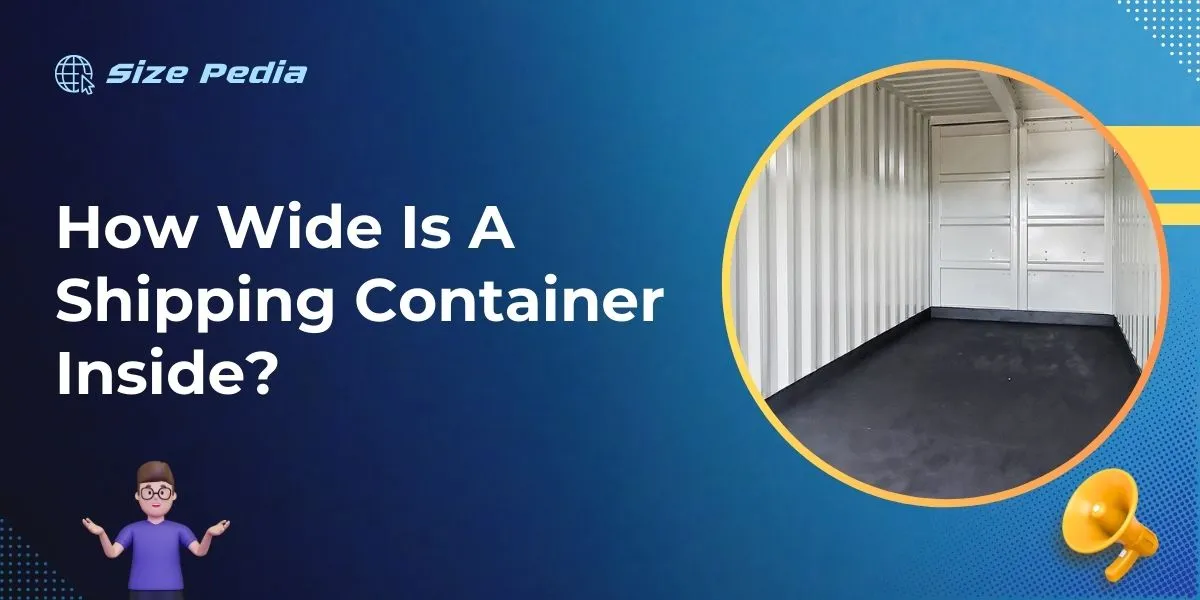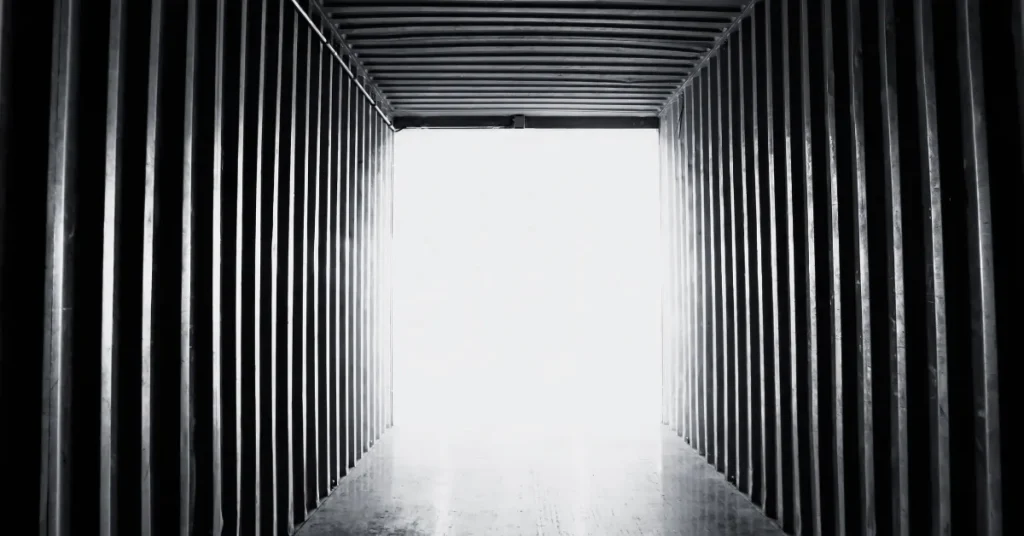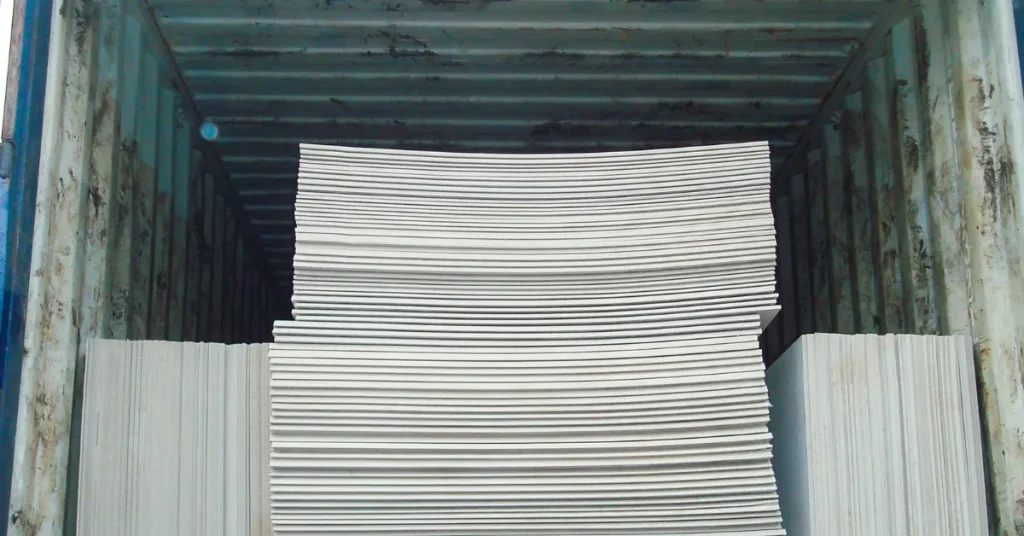The interior width of a standard shipping container is typically 7 feet 8 inches (2.33 meters). A high-cube container offers slightly more width, at 7 feet 8.5 inches (2.35 meters).
Shipping containers are the backbone of international trade, used for transporting a vast array of goods across the globe. These steel boxes come in various sizes, but the most common ones are the 20-foot and 40-foot lengths.
Knowing the interior dimensions of these containers is crucial for manufacturers, shipping companies, and logistics planners to maximize their cargo space.
The uniform size not only simplifies loading and stacking but also enables a seamless transfer from ship to truck or train.
As e-commerce and global trade continue to grow, understanding the dimensions and capacity of shipping containers remains integral to efficient and cost-effective supply chain management.
This knowledge ensures cargo is packed safely and optimally, reducing the risk of damage and additional shipping costs.

Dimensions Decoded: The Internal Space Of Shipping Containers
Understanding the exact size of a shipping container’s interior helps buyers and renters make informed decisions. Inside a shipping container, space is optimized for transporting goods efficiently and securely.
Knowing the internal dimensions is also crucial for those considering a shipping container for storage or as a building block for construction projects.
Let’s dive into the precise measurements that dictate the capacity of these versatile steel boxes.
Standard Sizes: 20ft And 40ft Containers
The two most common shipping container sizes are:
- 20-foot container
- 40-foot container
These sizes are industry standards, widely recognized for their utility and compatibility with shipping infrastructure worldwide.
20-foot containers are great for smaller shipments or space-restricted areas, while 40-foot containers offer double the length, perfect for larger projects and shipments.
Measuring Up: Internal Width, Length, And Height
The inside measurements of containers are:
| Container Size | Internal Width | Internal Length | Internal Height |
| 20ft | 2.35m | 5.9m | 2.39m |
| 40ft | 2.35m | 12.03m | 2.39m |
Width is consistent across both 20ft and 40ft containers, giving a nice, straight channel for loading cargo.
Length sees an obvious jump as we move from 20ft to 40ft. This extra space can be vital for larger items.
Height in standard containers remains the same, ensuring your goods can be stacked or stand tall.
Keep in mind these dimensions can vary slightly depending on the container manufacturer. Also, specialized containers like “High Cube” offer additional height for more vertical space.
Maximizing Space: The Design Behind Shipping Container Dimensions

Shipping containers revolutionized the transport industry with their ingenious design. A primary goal in their design was to maximize space efficiency. It is vital to understand the methods that containers use to offer such spacious interiors.
Both businesses and individuals use these containers for various purposes. This means their design must cater to a diverse range of needs. Let’s explore how these structures achieve their remarkable spatial economy.
Engineering Efficiency: How Containers Achieve Spaciousness
The design of shipping containers follows strict industry standards. This is to ensure that they are not only stackable but also spacious and durable. Sizes vary, but a standard container’s interior typically measures 19’4″ in length, 7’8″ in width, and 7’10” in height.
The walls of containers are made from corrugated steel, which provides strength without much thickness. Engineers use high-grade materials to ensure the container’s longevity, security, and ability to be re-used.
Packing Potential: Utilizing Every Inch Inside
The internal dimensions of shipping containers allow for optimal packing. Businesses strategically load goods to utilize every inch.
End-to-end and side-to-side, items can be arranged efficiently in these rectangles. This practice minimizes waste in transportation and storage. For instance, the width allows for two standard pallets to sit side by side.
- Vertical space is practical for stacking.
- Modular design allows for consistent packing and organization.
These features make shipping containers versatile for transport, storage, and even modular construction.
| Length | Width | Height |
| 19’4″ | 7’8″ | 7’10” |
Beyond Cargo: Creative Uses Of Shipping Container Spaces
Shipping containers are not only for ocean freight. People think of new ways to use these steel boxes every day. From homes to shops, the possibilities are endless. Let’s discover the innovative and creative uses for the spacious interiors of shipping containers.
Innovative Living: Containers As Homes And Offices
Shipping containers offer a unique twist to traditional living and working spaces. With customization, these structures transform into modern, stylish, and sustainable homes and offices.
- Custom layouts: Design your dream space inside a container.
- Stackable designs: Build upwards, creating multi-level structures.
- Eco-friendly solutions: Add solar panels or green roofs for sustainability.
Many admire these creative habitats for their affordability and flexibility. With a standard width of 8 feet on the inside, containers can easily fit living essentials. Coupled with the length, usually 20 or 40 feet, these spaces turn into cozy, yet roomy, abodes or offices.
Event Spaces And Pop-up Shops: The Versatility Of Container Dimensions
Shipping containers are perfect for temporary or mobile event spaces. With their modular shape, they become pop-up shops, cafes, or exhibition stands in no time.
| Length | Width | Height | |
| Standard Container | 20 or 40 ft | 8 ft | 8.5 ft |
| High Cube Container | 20 or 40 ft | 8 ft | 9.5 ft |
These dimensions mean containers are spacious enough for any pop-up event. Creatives and business owners love them for their plug-and-play functionality. A container can pop up in a park today and appear in a bustling city street tomorrow.
Their metal walls can hold shelves or screens. The floors can support heavy foot traffic. All it takes is a little imagination to turn a container into a thriving event space.
Modifications And Customizations: Tailoring Container Space
Modifications and Customizations: Tailoring Container Space have become a staple in the realm of adaptive architecture and efficient space utilization.
The rigid structure of shipping containers offers a robust canvas for innovative modifications. From commercial to residential uses, the internal space of shipping containers can extend far beyond their original design with the right alterations.
Cutting And Extending: Altering Container Structures
Shipping containers are versatile structures that can transform with cutting and extending techniques. Key processes include:
- Door and window insertion: These improve access and natural light.
- Size adjustments: Sections sliced off or added to fit specific dimensions.
- Joining containers: Creating larger spaces by securely connecting units side by side or stacking them.
Experts recommend reinforcing openings and joins to maintain structural integrity. This ensures safety and longevity of the modified containers.
Interior Design Strategies For Expanded Utility
The interior layout of containers can optimize for numerous applications:
| Function | Design Strategy |
| Living Space | Built-in furniture and multi-functional elements. |
| Office | Open-concept designs and smart storage solutions. |
| Workshop | Custom workbenches and tool organizers. |
Optimizing for utility often includes insulation upgrades and climate control systems for comfort. Incorporating such elements gives containers a new life, tailored to users’ specific needs.
Real-life Comparisons: How Container Dimensions Stack Up

Let’s put shipping container sizes into perspective by comparing them with spaces we are familiar with. This closer look will help you visualize just how spacious containers can be.
Containers Vs. Traditional Storage Spaces
Imagine a typical bedroom measuring 10 by 10 feet. A standard 20-foot shipping container is about the same width but doubles the length, offering significantly more storage capacity.
Peeking inside, you would see a space ready to hold furnishings from a three-bedroom house.
| Space | Dimensions | Container Equivalent |
| Bedroom | 10’x10′ | 1/2 of a 20′ container |
| Single-Car Garage | 12’x22′ | 1 of a 20′ container |
| Standard Living Room | 16’x20′ | Almost 1 of a 40′ container |
Visualizing Volume: Containers In Common Scenarios
In a park, a container could store all the play structures. Picture a slide, swings, and a sandbox, with room to spare.
Or think of a science lab in a school; a container could fit numerous lab benches and scientific tools. These illustrations show the remarkable room inside a shipping container.
- A slide, swings, sandbox fit with extra space in a 40′ container.
- Multiple lab benches, equipment arranged neatly within a single container.
FAQs About How Wide Is A Shipping Container Inside
What Are The Inside Dimensions Of A 40-foot Shipping Container?
The inside dimensions of a 40-foot shipping container typically measure 39′ 6″ in length, 7′ 9″ in width, and 7′ 10″ in height.
What Are The Interior Dimensions Of A 20 Foot Shipping Container?
The interior dimensions of a standard 20-foot shipping container are approximately 19’4″ in length, 7’8″ in width, and 7’10” in height.
Do Shipping Containers Come Wider Than 8 Ft?
Standard shipping containers typically measure 8 feet in width. While rare, some specialized containers may exceed this standard, offering wider storage capabilities for specific needs.
Can A Car Fit In A Shipping Container?
Yes, a car can fit in a shipping container. Standard containers are 20 or 40 feet long, providing ample space for most vehicles.
Conclusion
Summing up, the interior dimensions of shipping containers vary based on type and size. Standard containers typically measure 7 feet 8 inches wide, offering ample space for a range of cargo.
Understanding these measurements ensures efficient packing and transportation planning, essential for logistics success.
Choose wisely to match your shipping needs.
Resources:
1. https://www.smithsonianmag.com/innovation/shipping-container-idea-before-time-180963730/
